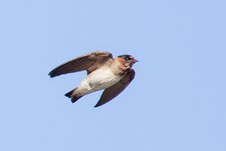How birds adapt to traffic
By Jack Dumbacher
We know that birds have been adapting to life in human landscapes. They change their songs to stand out against the urban background din, they sing at times of day when they are more likely to be heard over our noise, and several recent studies have shown that they have been adapting to avoid traffic hazards.
Some 80 million birds are estimated to die each year on American roads, and two groups of avian biologists took observations from their daily commute to learn about how birds are adjusting.
Charles Brown has studied Cliff Swallows for many years in Nebraska. Although the birds typically nest in mud banks and cliffs, they have taken to nesting in highway bridges and overpasses. While this creates excellent nesting habitat, it may not be the safest place for flying.

For years, Brown collected dead swallows from the roadside and prepared these specimens for the local museum. Over the years, he noticed that Cliff Swallow road kill numbers were declining, but he was unable to find a correlation with their population sizes or the numbers nesting near roads.
Careful measurements showed that birds with longer wings (and therefore less agile) were more likely to be struck and killed by cars – and that overall, this natural selection was causing wing length to become shorter in this population of swallows. Thus, he was able to show that auto traffic was killing the less agile swallows and selecting for more agile, shorter-winged swallows! [1]
Another study, just out, suggests that birds actually can tell the speed limit on local stretches of road. [2]
Pierre Lagagneux had a long commute through towns and countryside in his little Peugeot. To pass the time, he started measuring the distance from him that birds initiated their flight as he was approaching (his so-called Flight Initiation Distance, or FID). This was easy to do, by simply multiplying his speed by the time it took to reach the place where the bird flew. By measuring hundreds of birds in lots of different places, he was able to show that birds had longer FIDs in faster speed zones, and they had shorter FIDs in slow zone – regardless of the speed that the approaching car was going.
Thus, they were not estimating the speed of the particular oncoming car; rather, they formulated some estimate of the local speed limit. Most of the data for the study were from three common bird species (crows, European Blackbirds, and House Finches) and he also found that larger birds had larger FID than smaller birds in the same zone, mostly because it took them longer to become airborne. Naïve birds in the spring and summer appear to have shorter FIDs – and might need to do a little learning (or maybe go through a round of natural selection), but the FIDs are longer in the autumn and winter.

So birds are adapting to the challenges of human environments. The big question is whether birds can adapt fast enough to persist in ever-changing human environments. And hopefully there will be more than just crows, blackbirds, and House Sparrows to study in these urban landscapes in the future…
1. Brown, C.R. and M.B. Brown, Where has all the road kill gone? Current Biology, 2013. 23(6): p. R233-R234.
2. Legagneux, P. and S. Ducatez, European birds adjust their flight initiation distance to road speed limits. Biology Letters, 2013. 9(5): p. 20130417-20130417.
——————————
Jack Dumbacher is Chair of the Department of Ornithology and Mammalogy at California Academy of Sciences. A frequent presenter at the American Ornithologists’ Union and other conferences, Jack is an author of more than two dozen scholarly articles on birds. He is a member of the GGBA Board of Directors and chairs the San Francisco Conservation Committee for GGBA.
